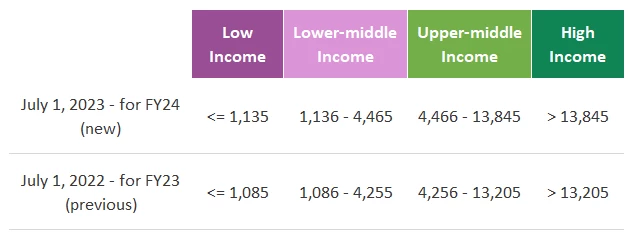The World Bank Group assigns the world’s economies[1] to four income groups – low, lower-middle, upper-middle, and high. The classifications are updated each year on July 1, based on the GNI per capita of the previous calendar year. GNI measures are expressed in United States dollars[2] using conversion factors derived according to the Atlas method, which in its current form was introduced in 1989[3]. The World Bank’s income classification aims to reflect a country’s level of development, drawing on Atlas GNI per capita as a broadly available indicator of economic capacity.
The classification of countries into income categories has evolved significantly over the period since the late 1980s. In 1987, 30% of reporting countries were classified as low income, while in 2022 only 12% fell into this category. The extent of this decline is different between world regions, with the Sub-Saharan African region’s proportion of low-income countries falling from 74% to 46% in 2022, East Asia Pacific from 26% to 3%, and South Asia from 100% to 13% as economies moved to higher categories over this period. This is depicted visually in the diagram below, which shows the income patterns by region.
Classification changes
The updated country income classifications for FY24, based on the GNI per capita of 2022, are available here.
From a statistical perspective, classifications can change for two reasons:
- Changes to Atlas GNI per capita: In each country, factors such as economic growth, inflation, exchange rates, and population growth can all influence the level of Atlas GNI per capita. Revisions to improve methods and data can also have an impact. Updated data on Atlas GNI per capita for 2022 can be accessed here.
- Changes to classification thresholds: To keep income classification thresholds fixed in real terms, they are adjusted annually for inflation using the Special Drawing Rights (SDR) deflator, a weighted average of the GDP deflators of China, Japan, the United Kingdom, the United States, and the Euro Area. The new thresholds for Atlas GNI per capita are as follows:
The chart below shows the economies moving to a new income category this year:
Not surprisingly, of countries changing income categories in 2022, virtually all moved to a higher category as the recovery from the COVID-19 pandemic continued. In terms of Atlas GNI per capita, roughly 80% of countries showed improvement in 2022 vis-à-vis the pre-pandemic period (2019).
Both Guyana and American Samoa are moving from upper-middle to the high income category this year. The large increase in Guyana’s Atlas GNI per capita is driven by the increasing volume of oil and gas production which more than doubled in 2022. The nominal increase was further amplified by higher oil and gas prices, and despite strong increases in outflows of primary income abroad, Guyana’s nominal GNI jumped 86.2% leading to a 60.0% increase in Atlas GNI per capita. In American Samoa the increase in Atlas GNI per capita in 2022 was mainly due to a substantial downward revision (-18.3%) to population estimates by the United Nations Population Division, reflecting new available data from the 2020 census.
El Salvador, Indonesia, and West Bank and Gaza all had Atlas GNI very close to the upper-middle income threshold in 2021, so modest GDP growth in 2022 was enough to bring these economies into this category. The Salvadorean economy saw 2.6% real GDP growth, while Indonesia continued its strong post pandemic recovery and real GDP increased 5.3%. Following strong post-pandemic growth in 2021 (7.9%), 3.9% growth in 2022 was sufficient for West Bank and Gaza to cross the threshold into the upper-middle income category.
Guinea and Zambia both moved from the low income to the lower-middle income category this year. Despite political instability and supply disruptions in agriculture, the Guinea economy grew 4.7% in 2022, boosted by a strong mining sector. Zambia’s economy grew 4.7% in 2022, combined with 8.6% inflation (measured by the GDP deflator), which led nominal GNI to increase by 17.7% and Atlas GNI per capita by 13.6%.
Jordan was the only country with a downward classification change this year, mainly the result of a large upward revision (+8.6%) to population estimates published by the United Nations Population Division reflecting new data from the latest population census.
More information
Detailed information on how the World Bank Group classifies countries is available here. The country and lending groups page provides a complete list of economies classified by income, region, and World Bank lending status and includes links to prior years’ classifications. The classification tables include World Bank member countries, along with all other economies with populations greater than 30,000. These classifications reflect the best available GNI figures for 2022, which may be revised as countries publish improved final estimates.
Data for GNI, GNI per capita, GDP, GDP PPP, and Population for 2022 are now available on the World Bank's Open Data Catalog. Note that these are estimates and may be revised. For more information, please contact us at data@worldbank.org.
[1] The term country, used interchangeably with economy, does not imply political independence but refers to any territory for which authorities report separate social or economic statistics.
[2] In countries where dual or multiple exchange rates are in use, the exchange rate used to convert local currency units to US$ is an average of these exchange rates, provided necessary data are available.
[3] For data beginning in reference year 1987.
The authors are pleased to acknowledge the essential contributions of our colleagues, Shwetha Eapen, Charles Kouame, Tamirat Yacob, and Kathryn Young, to the preparation of this piece.
Please note: The country classification described here aims to serve analytical purposes and changes have no direct impact on the eligibility for World Bank resources. In the classification used for World Bank operational purposes, a range of additional criteria are considered to determine country eligibility and the terms and conditions of Bank financing. For more information, please see Bank Directive, Financial Terms and Conditions of Bank Financing.





Join the Conversation